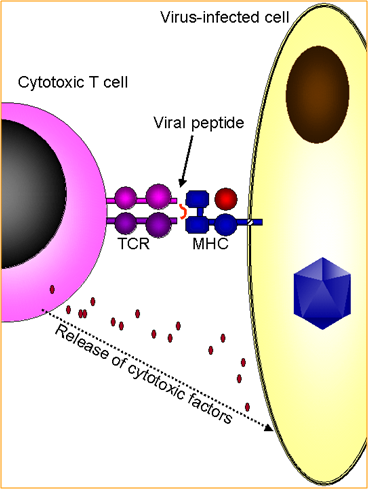Immune responses to viruses
Kerry Laing, Fred Hutchinson Cancer Research Centre, Seattle, USA
Via cytotoxic cells
When a virus infects a person (host), it invades the cells of its host in order to survive and replicate. Once inside, the cells of the immune system cannot ‘see’ the virus and therefore do not know that the host cell is infected. To overcome this, cells employ a system that allows them to show other cells what is inside them – they use molecules called class I major histocompatibility complex proteins (or MHC class I, for short) to display pieces of protein from inside the cell upon the cell surface. If the cell is infected with a virus, these pieces of peptide will include fragments of proteins made by the virus.
A special cell of the immune system called a T cell circulates looking for infections. One type of T cell is called a cytotoxic T cell because it kills cells that are infected with viruses with toxic mediators. Cytotoxic T cells have specialised proteins on their surface that help them to recognise virally-infected cells. These proteins are called T cell receptors (TCRs). Each cytotoxic T cell has a TCR that can specifically recognise a particular antigenic peptide bound to an MHC molecule. If the T cell receptor detects a peptide from a virus, it warns its T cell of an infection. The T cell releases cytotoxic factors to kill the infected cell and, therefore, prevent survival of the invading virus (Figure 1).
Immune responses to viruses - Figure 1
Viruses are highly adaptable, and have developed ways to avoid detection by T cells. Some viruses stop MHC molecules from getting to the cell surface to display viral peptides. If this happens, the T cell doesn’t know there’s a virus inside the infected cell.
However, another immune cell specialises in killing cells that have a reduced number of MHC class I molecules on their surface – this cell is a natural killer cell or NK cell for short. When the NK cell finds a cell displaying fewer than normal MHC molecules it releases toxic substances, in a similar way to cytotoxic T cells, which kill the virally-infected cell.
Cytotoxic cells are armed with preformed mediators. Cytotoxic factors are stored inside compartments called granules, in both cytotoxic T cells and NK cells, until contact with an infected cell triggers their release. One of these mediators is perforin, a protein that can make pores in cell membranes; these pores allow entry of other factors into a target cell to facilitate destruction of the cell. Enzymes called granzymes are also stored in, and released from, the granules. Granzymes enter target cells through the holes made by perforin.
Once inside the target cell, they initiate a process known as programmed cell death or apoptosis, causing the target cell to die. Another released cytotoxic factor is granulysin, which directly attacks the outer membrane of the target cell, destroying it by lysis. Cytotoxic cells also newly synthesise and release other proteins, called cytokines, after making contact with infected cells. Cytokines include interferon-g and tumour necrosis factor-a, and transfer a signal from the T cell to the infected, or other neighbouring cells, to enhance the killing mechanisms.
Via interferons
Virally infected cells produce and release small proteins called interferons, which play a role in immune protection against viruses. Interferons prevent replication of viruses, by directly interfering with their ability to replicate within an infected cell. They also act as signalling molecules that allow infected cells to warn nearby cells of a viral presence – this signal makes neighbouring cells increase the numbers of MHC class I molecules upon their surfaces, so that T cells surveying the area can identify and eliminate the viral infection as described above.
Via antibodies
Viruses can also be removed from the body by antibodies before they get the chance to infect a cell. Antibodies are proteins that specifically recognise invading pathogens and bind (stick) to them. This binding serves many purposes in the eradication of the virus:
Firstly, the antibodies neutralise the virus, meaning that it is no longer capable of infecting the host cell.
Secondly, many antibodies can work together, causing virus particles to stick together in a process called agglutination. Agglutinated viruses make an easier target for immune cells than single viral particles.
A third mechanism used by antibodies to eradicate viruses, is the activation of phagocytes. A virus-bound antibody binds to receptors, called Fc receptors, on the surface of phagocytic cells and triggers a mechanism known as phagocytosis, by which the cell engulfs and destroys the virus.
Finally, antibodies can also activate the complement system, which opsonises and promotes phagocytosis of viruses. Complement can also damage the envelope (phospholipid bilayer) that is present on some types of virus
Immune responses to viruses - Figure 2a
Immune responses to viruses - Figure 2b
Immune responses to viruses © The copyright for this work resides with the author
Bitesize category
Pathogens and Disease
免疫系统对病毒的反应
通过细胞毒性T细胞和天然杀伤细胞(NK细胞)
当病毒感染一个人(宿主)时,它会入侵其宿主细胞以生存和增殖。一旦进入体内,免疫系统的细胞就无法“看到”病毒,因此不知道宿主细胞已被感染。为了克服这个问题,细胞采用了一种系统,使它们能够向其他细胞展示其内部结构–他们使用称为I类主要组织相容性复合蛋白(简称MHC I类)的分子在细胞表面展示细胞内的蛋白质碎片。如果细胞感染了病毒,则这些肽段将包含由病毒产生的蛋白质片段。
免疫系统的一个称为T细胞的特殊细胞在血液中循环寻找感染,被称为细胞毒性T细胞,因为它可以用有毒的因子杀死感染了病毒的细胞。细胞毒性T细胞在其表面上具有特殊的蛋白质,可帮助它们识别被病毒感染的细胞。这些蛋白质称为T细胞受体(TCR)。每个细胞毒性T细胞均具有TCR,该TCR可以特异性识别与MHC分子结合的特定抗原肽。如果T细胞受体(TCR)从病毒中检测到肽,则会警告T细胞感染。 T细胞释放细胞毒性因子杀死被感染的细胞,因此阻止了入侵病毒的存活(图1)。
对病毒的免疫反应-图1
病毒具有高度适应性,并已开发出避免T细胞检测的方法。一些病毒阻止MHC分子进入细胞表面以展示病毒肽。如果发生这种情况,则T细胞不知道被感染的细胞内部存在病毒。
但是,另一种免疫细胞专门杀死表面上MHC I类分子数量减少的细胞-这种细胞简而言之是天然杀伤细胞或NK细胞。当NK细胞发现显示比正常MHC分子少的细胞时,它会释放有毒物质,类似于杀死病毒感染细胞的细胞毒性T细胞。细胞毒性细胞配备有预先形成的介质。细胞毒性因子储存在细胞毒性T细胞和NK细胞中称为颗粒的隔室中,直到与感染的细胞接触触发其释放。这些介质之一是穿孔素(Proforin),它是一种可以在细胞膜上形成孔的蛋白质。这些孔允许其他因素进入靶细胞以促进细胞的破坏。称为颗粒酶(Granzyme)的酶也存储在颗粒中并从颗粒中释放出来。颗粒酶通过穿孔素产生的孔进入靶细胞。
一旦进入靶细胞,它们就会启动一个称为程序性细胞死亡或凋亡的过程,从而导致靶细胞死亡。另一种释放的细胞毒性因子是颗粒溶素(Granulysin),它直接攻击靶细胞的外膜,并通过裂解将其破坏。与被感染的细胞接触后,细胞毒性细胞还可以新合成并释放其他蛋白质,称为细胞因子。细胞因子包括干扰素-g和肿瘤坏死因子-a,并将信号从T细胞传递到受感染的细胞或其他邻近细胞,以增强杀伤机制。
通过干扰素
被病毒感染的细胞产生并释放称为干扰素的小蛋白质,这些蛋白质在针对病毒的免疫保护中起作用。干扰素通过直接干扰病毒在受感染细胞内的复制能力来防止病毒复制。它们还充当信号分子,使被感染的细胞警告附近的细胞有病毒存在-该信号使邻近细胞增加其表面MHC I类分子的数量,从而使T细胞在该区域进行调查可以识别并消除病毒感染如上所述。
通过抗体
病毒也可以通过抗体从体内清除,然后才有机会感染细胞。抗体是特异性识别入侵病原体并与其结合(粘附)的蛋白质。这种结合在消除病毒方面有许多目的:
首先,抗体中和了病毒,这意味着它不再能够感染宿主细胞。
其次,许多抗体可以协同作用,从而导致病毒颗粒在称为凝集的过程中粘在一起。凝集的病毒比单个病毒颗粒更容易成为免疫细胞的靶标。
抗体消除病毒的第三个机制是吞噬细胞的激活。病毒结合的抗体与吞噬细胞表面上的称为Fc受体的受体结合,并触发一种称为吞噬作用的机制,细胞吞噬并破坏病毒。
最后,抗体还可以激活补体系统,从而调理并促进病毒的吞噬作用。补体还会破坏某些类型病毒中存在的包膜(磷脂双层)Immune responses to viruses | British Society for Immunology
https://www.immunology.org/public-information/bitesized-immunology/pathogens-and-disease/immune-responses-viruses
CH21 Antibody-Mediated Immunity
http://www.apsubiology.org/anatomy/2020/2020_Exam_Reviews/Exam_2/CH21_Antibody_Mediated_Immunity.htm



